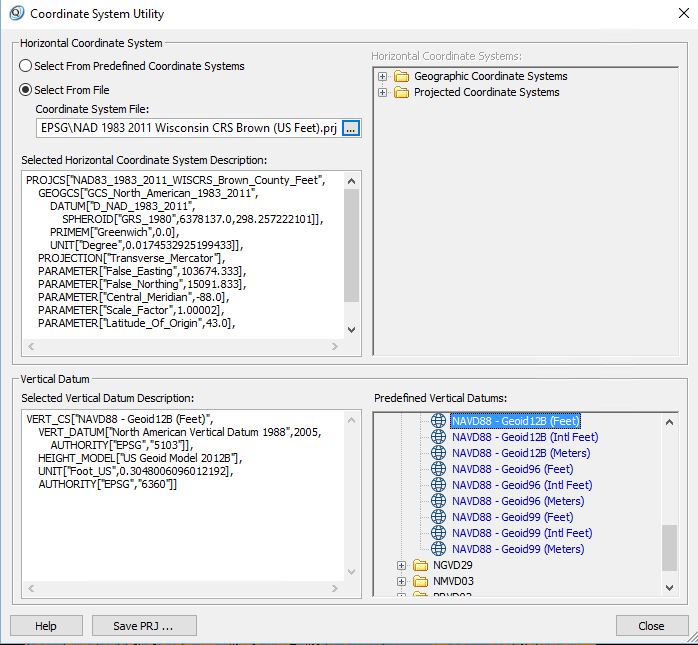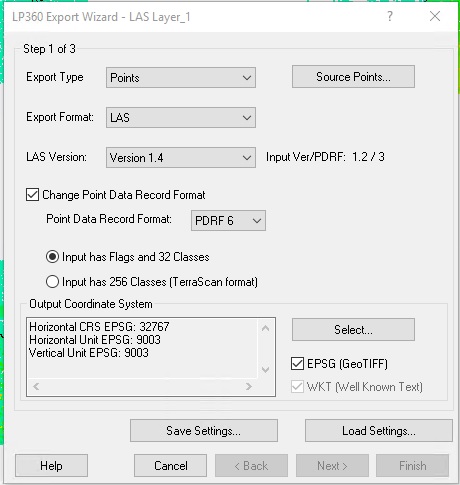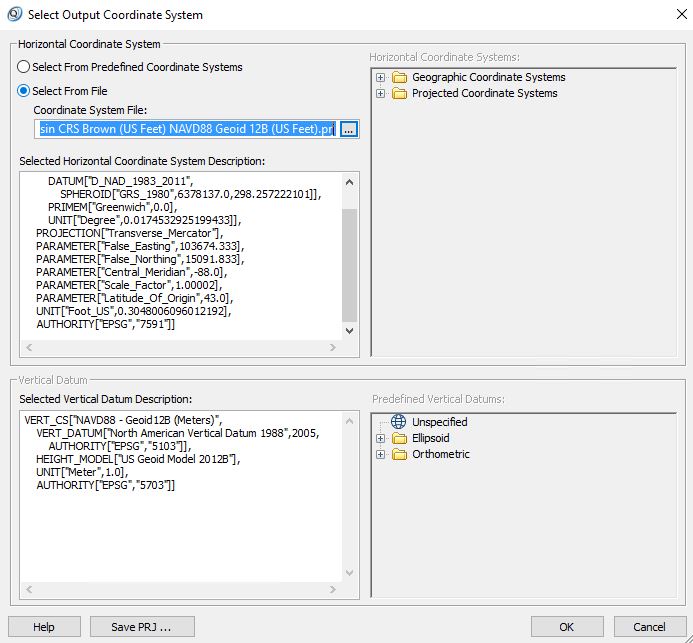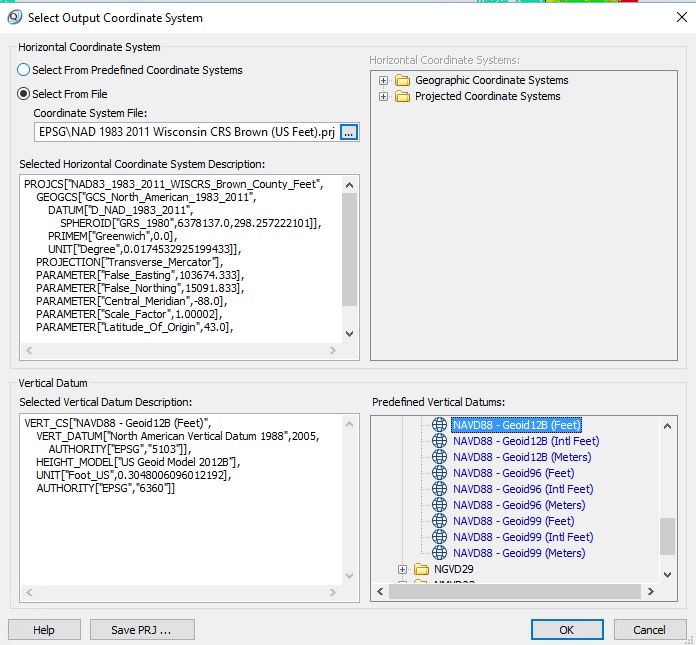There may be times when a user needs to add a custom horizontal coordinate system to the program. This option can be done within LP360 (v2015.1).
Initial steps
- Generate a custom PRJ file to reflect the new custom coordinate system
- There are a couple of options how to accomplish this
- Copy a current PRJ file and make the necessary changes to the PRJ file
- Download a PRJ file from an online source, such as http://spatialreference.org/
- There are a couple of options how to accomplish this
- Provide a unique name for the new horizontal coordinate system
LP360 for Windows: Coordinate System Utility
To add a horizontal coordinate system not available in LP360 one must first create a combined horizontal and vertical projection file for use when outputting files:
- Under File select Coordinate System Utility
- Under Horizontal Coordinate System, choose the radio button for “Select From File”
- Browse to the location of your custom projection file
- Specify a predefined Vertical Coordinate System
- Select “Save PRJ…” to save the file containing both the horizontal and vertical CRS to disk
LP360 for Windows: Export Wizard
To assign the combined custom horizontal and vertical projection to output LAS Files:
- Add LIDAR data within LP360
- Open the Export Wizard
- Specify the LAS version to export
- Click Select to specify the Output Coordinate System
- Under Horizontal Coordinate System choose the radio button for “Select From File”
- Browse to the location of the the combined horizontal and vertical projection file created using the Coordinate System Utility
LP360 for ArcGIS: Export Wizard
To assign the custom horizontal coordinate system to output LAS Files:
- Add LIDAR data within LP360
- Open the Export Wizard
- Specify the LAS version to export
- Click Select to specify the Output Coordinate System
- Under Horizontal Coordinate System choose the radio button for “Select From File”
- Browse to the location of the custom projection file
- Specify a predefined Vertical Coordinate System
Authority Codes
LP360 does not automatically incorporate the EPSG or other authority codes from the provided PRJ. One must manually add the authority code to two separate files found in the LP360 Common files directory. The two files are “C:\Program Files\Common Files\QCoherent\CoordSysWKTs.xml” and “C:\Program Files\Common Files\QCoherent\nad\esri”. The former file is used for putting the PRJ into the “Select Coordinate System” dialog, and the latter file is used by LP360 for getting the codes associated with a projection, and vice versa. When modifying these files it is important to have the correctly formatted information, in the respective files. The required information should be copied directly from the PRJ file used above. It is best to make a copy of these files before making any modifications, and test them after the modifications have been made.
CoordSysWKTs.xml
GCCoordinateSystemNode
m_Nodes
Key: GCCoordinateSystemNode
Key: m_Nodes
Key: m_strName
Value: CRS Name
Key: m_strWKT
Value: WKT string
Example:
<GCCoordinateSystemNode>
<m_Nodes />
<m_strName>ETRS_1989_UTM_Zone_N32</m_strName>
<m_strWKT>PROJCS[“‘ETRS_1989_UTM_Zone_N32′”,GEOGCS[“‘GCS_ETRS_1989′”,DATUM[“D_ETRS_1989′”,SPHEROID[“GRS_1980”,6378137.0,298.257222101]],PRIMEM[“‘Greenwich'”,0.0],UNIT[“Degree”,0.017453292519943295]],PROJECTION[“‘Transverse_Mercator'”],PARAMETER[“‘False_Easting'”,32500000.0],PARAMETER[“‘False_Northing'”,0.0],PARAMETER[“‘Central_Meridian'”,9.0],PARAMETER[“‘Scale_Factor'”,0.9996],PARAMETER[“‘Latitude_Of_Origin'”,0.0],UNIT[“‘Meter'”,1.0]],AUTHORITY[“EPSG”,4647]]</m_strWKT>
</GCCoordinateSystemNode>
esri
#CRS Name
Proj4 Styled CRS (Many are available from an online source, such as http://spatialreference.org/)
Example:
# ETRS89 / UTM zone N32
<4647> +proj=tmerc +lat_0=0.000000000 +lon_0=9.000000000 +k=0.99960 +x_0=32500000.000 +y_0=0.000 +ellps=GRS80 +units=m




